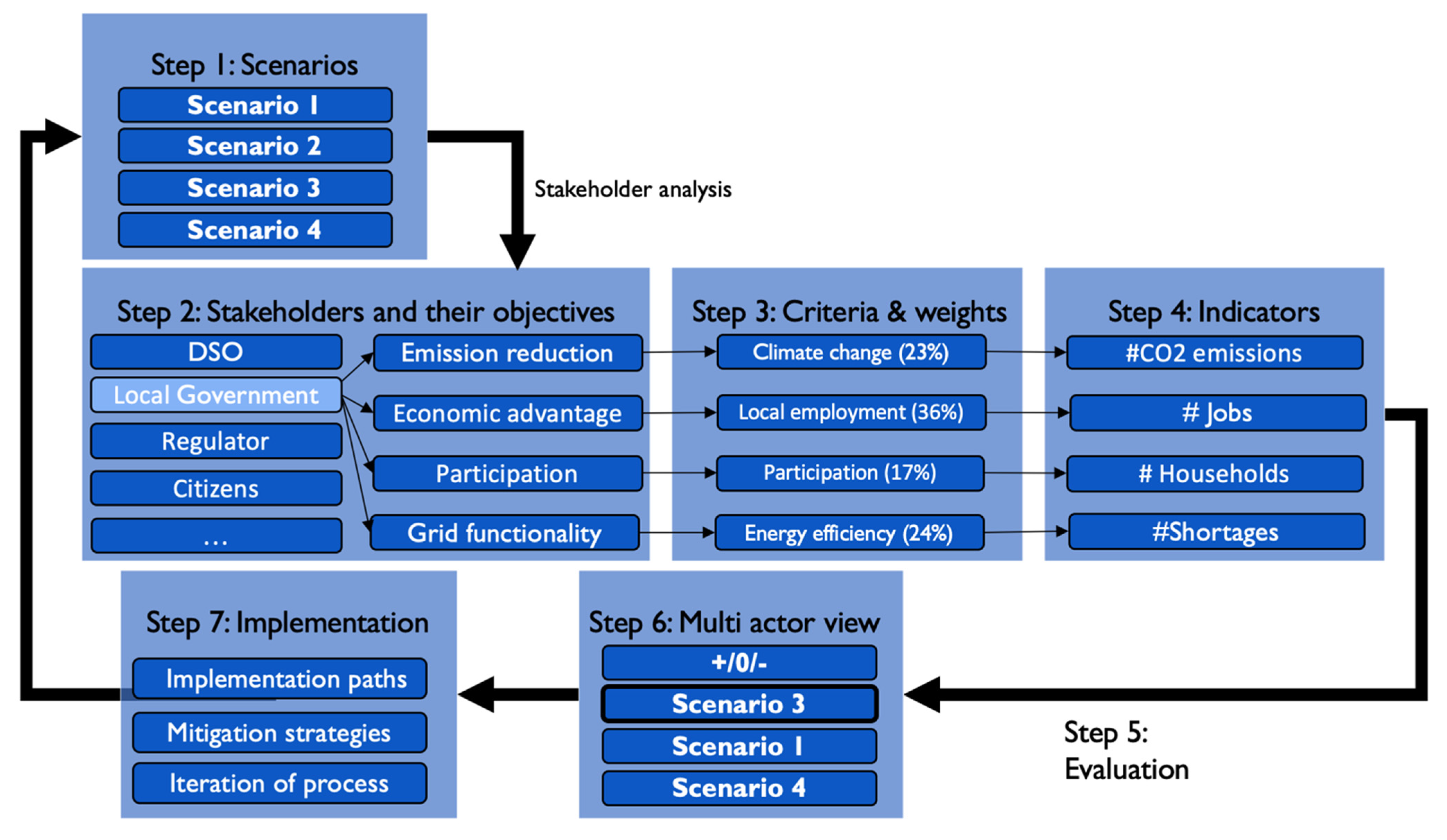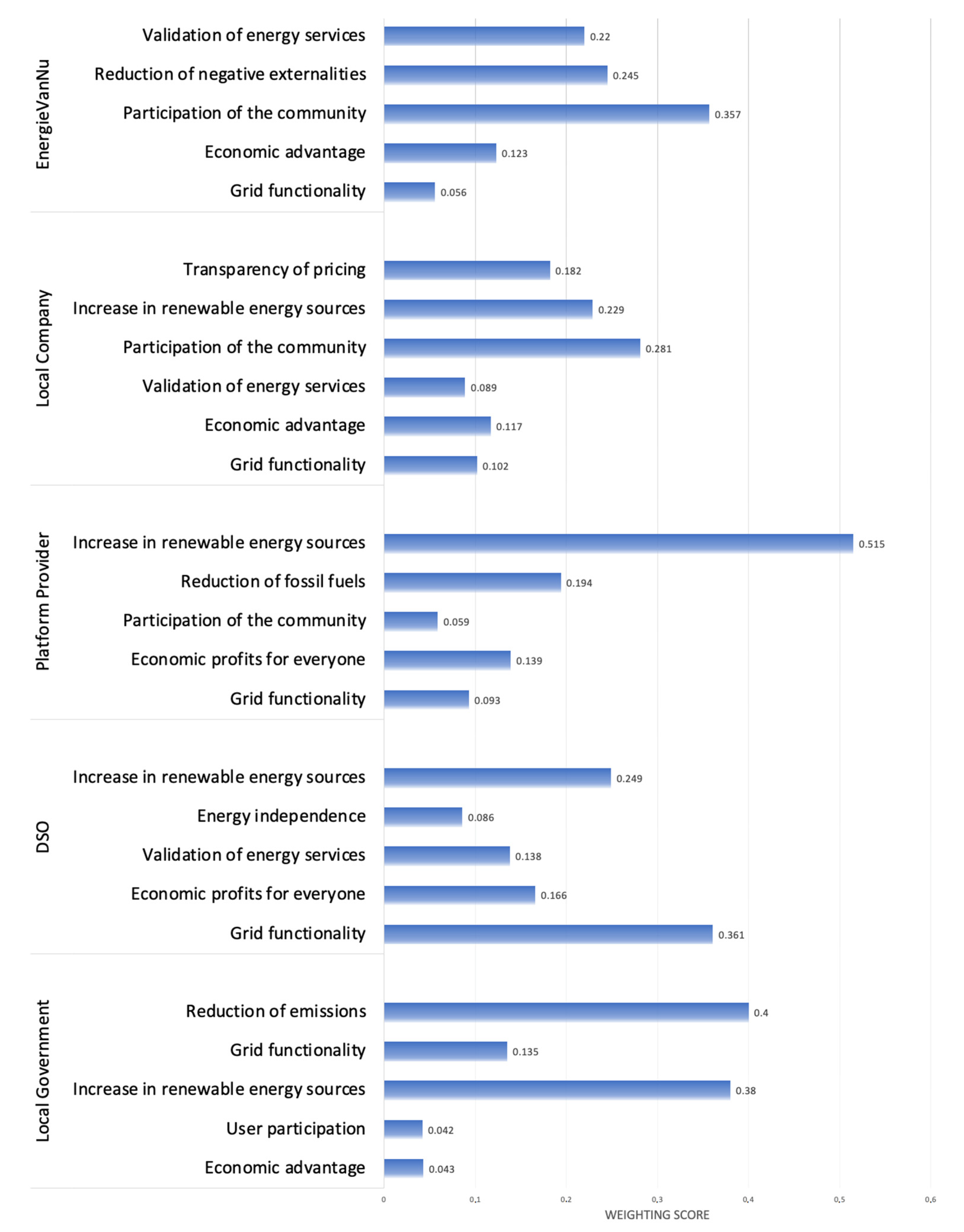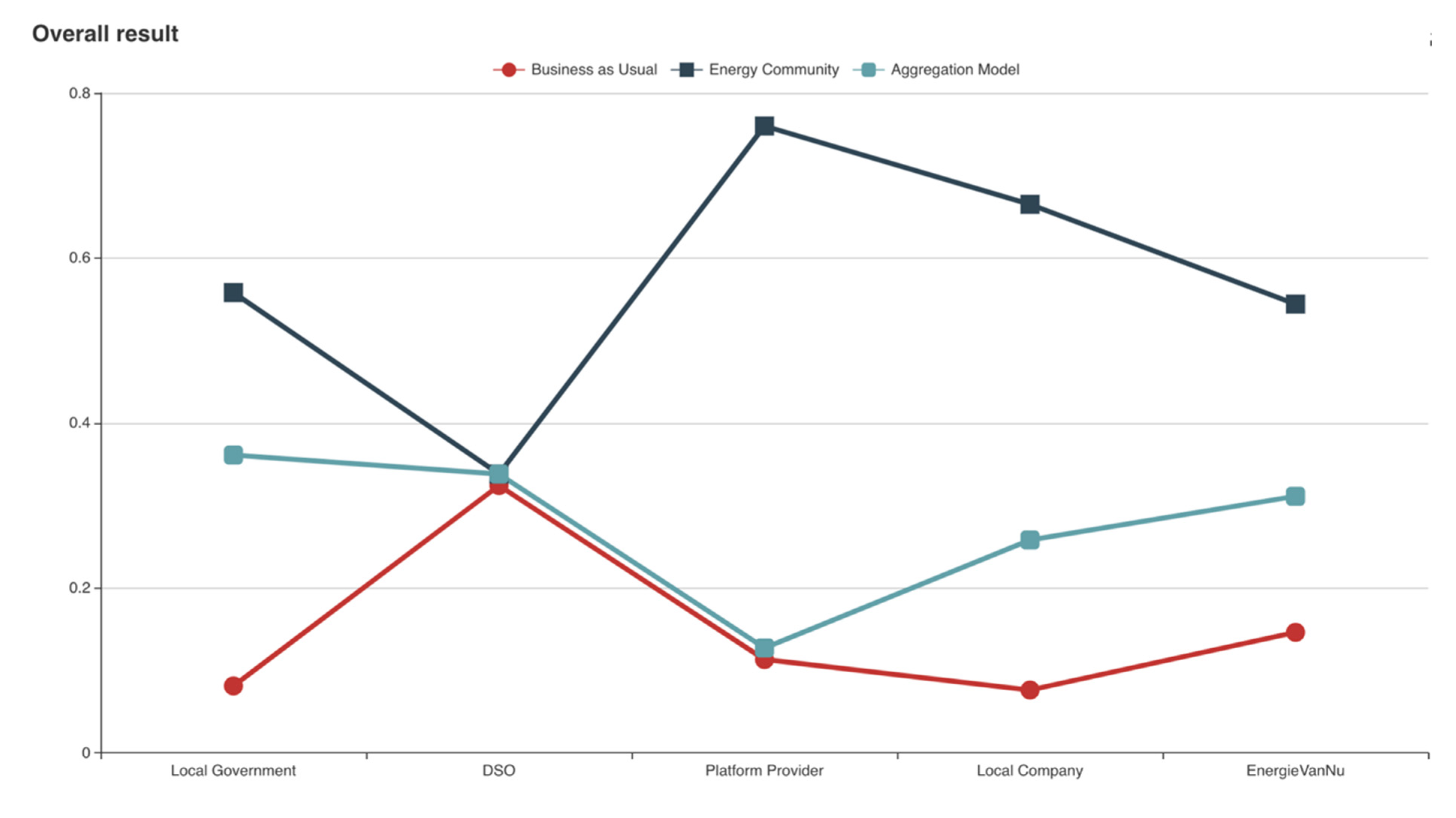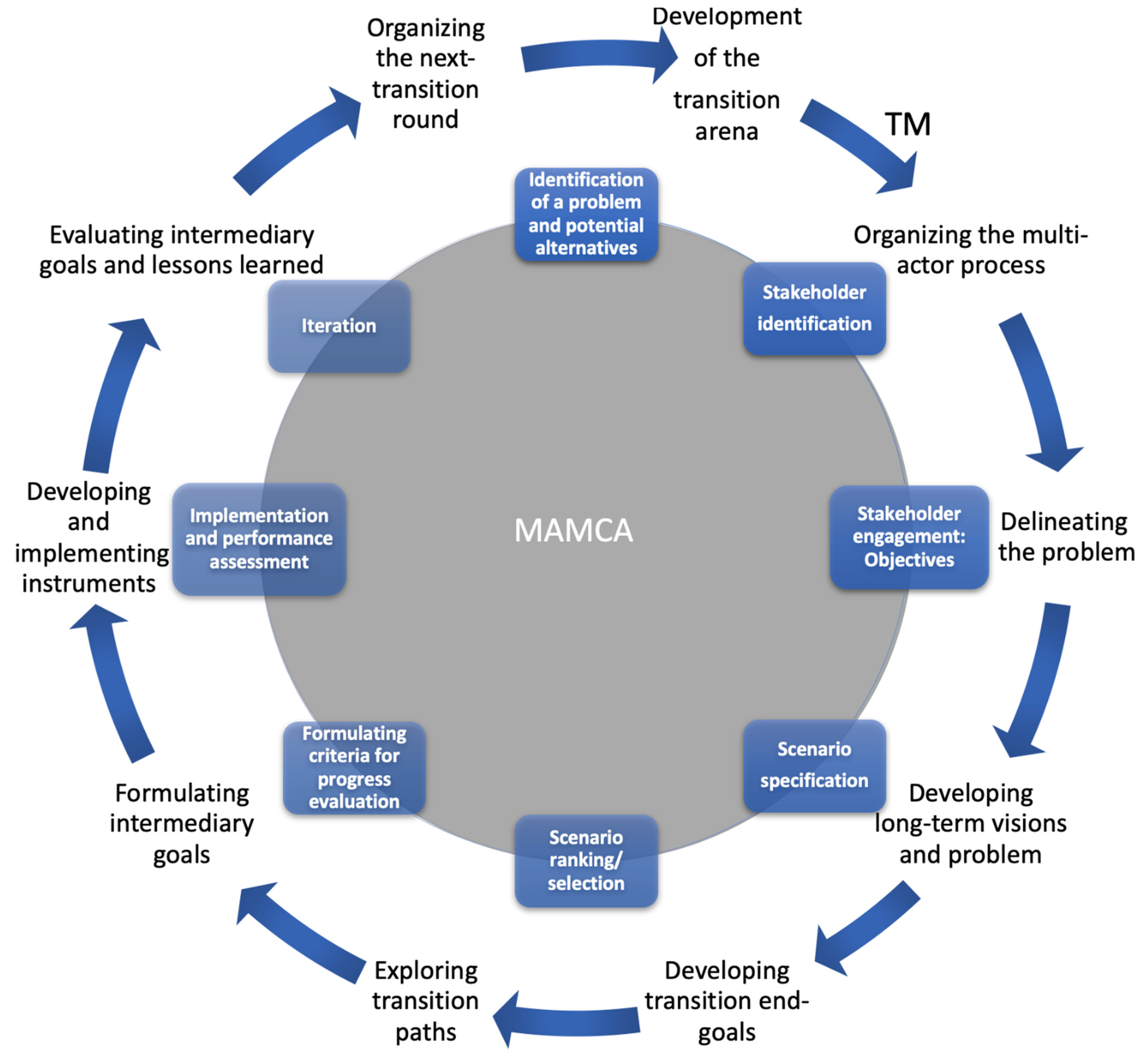Application of Multi-Actor Multi-Criteria Analysis for Transition Management in Energy Communities
Abstract
1. Introduction
2. Materials and Methods
2.1. Transition Management
- Development and set-up of a transition arena
- Organization of a multi-actor process
- Delineating the transition problems
- Development of long-term visions and long-term problem definition
- Development of transition end-goals that serve as a ground for back-casting methods
- Exploration of transition pathways
- Formulation of intermediary goals
- Agreement on the means and implementation of the goals
- Evaluation of intermediary goals and lessons learned
- Iteration
2.2. MAMCA
2.2.1. Defining the Problem and Alternatives:
2.2.2. Stakeholder Identification and Engagement
2.2.3. Criteria Definition and Weighting
2.2.4. Criteria Measurement and Measurement Methods
2.2.5. Overall Analysis and Ranking
2.2.6. Results
2.2.7. Implementation and Iteration
2.3. Case Study Design
3. Results
4. Discussion
5. Conclusions
Author Contributions
Funding
Informed Consent Statement
Acknowledgments
Conflicts of Interest
Appendix A
| Local Government | Emission Reductions | Grid Functionality | Increase of RES | User Participation | Economic Advantage | Score | |
|---|---|---|---|---|---|---|---|
| BAU | 0.062 | 0.223 | 0.054 | 0.055 | 0.071 | 0.081 | |
| EC | 0.715 | 0.692 | 0.306 | 0.738 | 0.723 | 0.558 | |
| AM | 0.223 | 0.084 | 0.64 | 0.207 | 0.206 | 0.361 | |
| DSO | Increase RES | Energy Independence | Validation of Energy Services | Economic Advantage | Grid Functionality | Score | |
| BAU | 0.111 | 0.143 | 0.143 | 0.143 | 0.667 | 0.324 | |
| EC | 0.444 | 0.429 | 0.429 | 0.429 | 0.167 | 0.338 | |
| AM | 0.444 | 0.429 | 0.429 | 0.429 | 0.167 | 0.338 | |
| Platform Provider | Increase of RES | Reduction of Fossil Fuels | Participation of the Community | Economic Profits for Everyone | Grid Functionality | Score | |
| BAU | 0.12 | 0.106 | 0.067 | 0.067 | 0.188 | 0.113 | |
| EC | 0.746 | 0.765 | 0.794 | 0.794 | 0.755 | 0.760 | |
| AM | 0.134 | 0.129 | 0.139 | 0.139 | 0.057 | 0.127 | |
| Local Company | Transparency of Pricing | Increaseof RES | Participation | Validation of Energy Services | Economic Advantages | Grid Functionality | Score |
| BAU | 0.072 | 0.061 | 0.061 | 0.12 | 0.108 | 0.085 | 0.076 |
| EC | 0.673 | 0.723 | 0.723 | 0.331 | 0.624 | 0.701 | 0.665 |
| AM | 0.255 | 0.216 | 0.216 | 0.549 | 0.267 | 0.213 | 0.258 |
| EnergieVanNu | Validation of Energy Services | Externalities | Participation of the Community | Economic Advantage | Grid Functionality | Score | |
| BAU | 0.346 | 0.106 | 0.068 | 0.159 | 0.095 | 0.146 | |
| EC | 0.11 | 0.633 | 0.685 | 0.589 | 0.651 | 0.544 | |
| AM | 0.544 | 0.26 | 0.247 | 0.252 | 0.254 | 0.311 |
References
- Frieden, D.; Tuerk, A.; Roberts, J.; D’Herbemont, S.; Gubina, A.F.; Komel, B. Overview of emerging regulatory frameworks on collective self-consumption and energy communities in Europe. In Proceedings of the 2019 16th International Conference on the European Energy Market (EEM), Ljubljana, Slovenia, 18–20 September 2019; IEEE: Washington, DC, USA, 2019; pp. 1–6. [Google Scholar]
- European Commission. Communication from the Commission to the European Parliament, the European Council, the Council, the European Economic and Social Committee, the Committee of the Regions and the European Investment Bank, a Clean Planet for All, a European Strategic Long-Term Vision for a Prosperous, Modern, Competitive and Climate Neutral Economy; European Commission: Brussels, Belgium, 2018. [Google Scholar]
- European Commission. Communication from the Commission to the European Parliament, the Council, the European Economic and Social Committee and the Committee of the Regions Energy Roadmap 2050; European Commission: Brussels, Belgium, 2011. [Google Scholar]
- Mendes, G.; Honkapuro, S.; Nylund, J.; Kilkki, O.; Annala, S.; Segerstam, J. Local Energy Markets: Opportunities, Benefits, and Barriers. In Proceedings of the CIRED Workshop, Ljubljana, Slovenia, 7–8 June 2018; CIRED: Liège, Belgium, 2018; p. 5. [Google Scholar]
- European Commission Directive (EU). 2018/2001 of the European Parliament and of the Council of 11 December 2018 on the Promotion of the Use of Energy from Renewable Sources. Off. J. Eur. Union 2018, 328, 82–209. [Google Scholar]
- European Commission Directive (EU). 2019/944 of the European Parliament and of the Council of 5 June 2019 on Common Rules for the Internal Market for Electricity and Amending Directive 2012/27/EU. Off. J. Eur. Union 2019, 158, 125–199. [Google Scholar]
- Gamboa, G.; Munda, G. The problem of windfarm location: A social multi-criteria evaluation framework. Energy Policy 2007, 35, 1564–1583. [Google Scholar] [CrossRef]
- Wolsink, M. The research agenda on social acceptance of distributed generation in smart grids: Renewable as common pool resources. Renew. Sustain. Energy Rev. 2012, 16, 822–835. [Google Scholar] [CrossRef]
- Wüstenhagen, R.; Wolsink, M.; Bürer, M.J. Social acceptance of renewable energy innovation: An introduction to the concept. Energy Policy 2007, 35, 2683–2691. [Google Scholar] [CrossRef]
- Hölscher, K.; Wittmayer, J.M.; Avelino, F.; Giezen, M. Opening up the transition arena: An analysis of (dis)empowerment of civil society actors in transition management in cities. Technol. Forecast. Soc. Chang. 2019, 145, 176–185. [Google Scholar] [CrossRef]
- Nagorny-Koring, N.C.; Nochta, T. Managing urban transitions in theory and practice—The case of the Pioneer Cities and Transition Cities projects. J. Clean. Prod. 2018, 175, 60–69. [Google Scholar] [CrossRef]
- Nevens, F.; Frantzeskaki, N.; Gorissen, L.; Loorbach, D. Urban Transition Labs: Co-creating transformative action for sustainable cities. J. Clean. Prod. 2013, 50, 111–122. [Google Scholar] [CrossRef]
- Noboa, E.; Upham, P. Energy policy and transdisciplinary transition management arenas in illiberal democracies: A conceptual framework. Energy Res. Soc. Sci. 2018, 46, 114–124. [Google Scholar] [CrossRef]
- Foxon, T.J.; Hammond, G.P.; Pearson, P.J. Developing transition pathways for a low carbon electricity system in the UK. Technol. Forecast. Soc. Chang. 2010, 77, 1203–1213. [Google Scholar] [CrossRef]
- Loorbach, D.; Rotmans, J. The practice of transition management: Examples and lessons from four distinct cases. Futures 2010, 42, 237–246. [Google Scholar] [CrossRef]
- Witt, T.; Dumeier, M.; Geldermann, J. Combining scenario planning, energy system analysis, and multi-criteria analysis to develop and evaluate energy scenarios. J. Clean. Prod. 2020, 242, 118414. [Google Scholar] [CrossRef]
- Loorbach, D. Transition Management: New Mode of Governance for Sustainable Development; International Books: Utrecht, The Netherlands, 2007; ISBN 978-90-5727-057-4. [Google Scholar]
- Dóci, G.; Vasileiadou, E.; Petersen, A.C. Exploring the transition potential of renewable energy communities. Futures 2015, 66, 85–95. [Google Scholar] [CrossRef]
- Rotmans, J.; Kemp, R.; Van Asselt, M. More evolution than revolution: Transition management in public policy. Foresight 2001, 3, 15–31. [Google Scholar] [CrossRef]
- Rotmans, J.; Loorbach, D. Complexity and Transition Management. J. Ind. Ecol. 2009, 13, 184–196. [Google Scholar] [CrossRef]
- Nevens, F.; Roorda, C. A climate of change: A transition approach for climate neutrality in the city of Ghent (Belgium). Sustain. Cities Soc. 2014, 10, 112–121. [Google Scholar] [CrossRef]
- Heiskanen, E.; Jalas, M.; Rinkinen, J.; Tainio, P. The local community as a “low-carbon lab”: Promises and perils. Environ. Innov. Soc. Transit. 2015, 14, 149–164. [Google Scholar] [CrossRef]
- Bos, J.; Brown, R.R.; Farrelly, M.A.; De Haan, F.J. Enabling sustainable urban water management through governance experimentation. Water Sci. Technol. 2013, 67, 1708–1717. [Google Scholar] [CrossRef] [PubMed]
- Bos, J.; Brown, R. Governance experimentation and factors of success in socio-technical transitions in the urban water sector. Technol. Forecast. Soc. Chang. 2012, 79, 1340–1353. [Google Scholar] [CrossRef]
- Macharis, C. The Importance of Stakeholder Analysis in Freight Transport. Available online: https://www.openstarts.units.it/bitstream/10077/5788/1/Macharis_ET25_26.pdf (accessed on 13 July 2020).
- Macharis, C.; Turcksin, L.; Lebeau, K. Multi actor multi criteria analysis (MAMCA) as a tool to support sustainable decisions: State of use. Decis. Support Syst. 2012, 54, 610–620. [Google Scholar] [CrossRef]
- Geels, F.W. Technological transitions as evolutionary reconfiguration processes: A multi-level perspective and a case-study. Res. Policy 2002, 31, 1257–1274. [Google Scholar] [CrossRef]
- Loorbach, D. Transition Management for Sustainable Development: A Prescriptive, Complexity-Based Governance Framework. Governance 2010, 23, 161–183. [Google Scholar] [CrossRef]
- Rip, A.; Kemp, R. Technological change. In Human Choice and Climate Change; Battelle: Columbus, OH, USA, 1998; Volume 2, pp. 327–399. [Google Scholar]
- Smith, A. Translating Sustainabilities between Green Niches and Socio-Technical Regimes. Technol. Anal. Strat. Manag. 2007, 19, 427–450. [Google Scholar] [CrossRef]
- Dirven, J.; Rotmans, J.; Verkaik, A.-P. Samenleving in Transitie; ICIS: Maastricht, The Netherlands, 2002; Volume 59. [Google Scholar]
- Hendriks, C.M. Policy design without democracy? Making democratic sense of transition management. Policy Sci. 2009, 42, 341–368. [Google Scholar] [CrossRef]
- Shove, E.; Walker, G. Caution! Transitions Ahead: Politics, Practice, and Sustainable Transition Management. Environ. Plan. A Econ. Space 2007, 39, 763–770. [Google Scholar] [CrossRef]
- Meadowcroft, J. What about the politics? Sustainable development, transition management, and long term energy transitions. Policy Sci. 2009, 42, 323–340. [Google Scholar] [CrossRef]
- Rauschmayer, F.; Bauler, T.; Schäpke, N. Towards a Governance of Sustainability Transitions: Giving Place to Individuals; Helmholtz-Zentrum für Umweltforschung (UFZ): Leipzig, Germany, 2013. [Google Scholar]
- Jhagroe, S.; Loorbach, D. See no evil, hear no evil: The democratic potential of transition management. Environ. Innov. Soc. Transitions 2015, 15, 65–83. [Google Scholar] [CrossRef]
- Avelino, F. Empowerment and the challenge of applying transition management to ongoing projects. Policy Sci. 2009, 42, 369–390. [Google Scholar] [CrossRef]
- Smith, A.; Stirling, A.; Berkhout, F. The governance of sustainable socio-technical transitions. Res. Policy 2005, 34, 1491–1510. [Google Scholar] [CrossRef]
- Smith, A.; Stirling, A. The Politics of Social-ecological Resilience and Sustainable Socio-technical Transitions. Ecol. Soc. 2010, 15, 11. [Google Scholar] [CrossRef]
- Johnstone, P.; Hielscher, S. Phasing out coal, sustaining coal communities? Living with technological decline in sustainability pathways. Extr. Ind. Soc. 2017, 4, 457–461. [Google Scholar] [CrossRef]
- Bosman, R.; Loorbach, D.; Rotmans, J. Van Raak, R. Carbon Lock-Out: Leading the Fossil Port of Rotterdam into Transition. Sustainability 2018, 10, 2558. [Google Scholar] [CrossRef]
- Burke, M.J.; Stephens, J.C. Political power and renewable energy futures: A critical review. Energy Res. Soc. Sci. 2018, 35, 78–93. [Google Scholar] [CrossRef]
- Feindt, P.H.; Weiland, S. Reflexive governance: Exploring the concept and assessing its critical potential for sustainable development. Introduction to the special issue. J. Environ. Policy Plan. 2018, 20, 661–674. [Google Scholar] [CrossRef]
- Keseru, I.; Coosemans, T.; Macharis, C. Scenarios for the Future of Mobility in Europe: Combining the Scenario Technique with the Multi-Actor Multi-Criteria Analysis (MAMCA); Vrije Universiteit Brussel: Brussels, Belgium, 2018; p. 8. [Google Scholar]
- Scannella, G.; Beuthe, M. Valuation of road projects with uncertain outcomes. Transp. Rev. 2003, 23, 35–50. [Google Scholar] [CrossRef]
- Conde, C.; Lonsdale, K.; Nyong, A.; Aguilar, I. Engaging Stakeholders in the Adaptation Process; Cambridge University Press: Cambridge, UK; New York, NY, USA, 2005; pp. 47–66. [Google Scholar]
- Costa, C.; Cunha, P.R. Who are the players? Finding and characterizing stakeholders in social networks. In Proceedings of the 2010 43rd Hawaii International Conference on System Sciences, Kauai, HI, USA, 5–8 January 2010; IEEE: Washington, DC, USA, 2010. [Google Scholar]
- Mitchell, R.K.; Agle, B.R.; Wood, D.J. Toward a Theory of Stakeholder Identification and Salience: Defining the Principle of who and What Really Counts. Acad. Manag. Rev. 1997, 22, 853–886. [Google Scholar] [CrossRef]
- Saaty, T.L. A scaling method for priorities in hierarchical structures. J. Math. Psychol. 1977, 15, 234–281. [Google Scholar] [CrossRef]
- Bowker, G.C.; Star, S.L. Sorting Things Out: Classification and Its Consequences; MIT Press: London, UK, 1999; ISBN 0-262-26160-X. [Google Scholar]
- Star, S.L. This is Not a Boundary Object: Reflections on the Origin of a Concept. Sci. Technol. Hum. Values 2010, 35, 601–617. [Google Scholar] [CrossRef]
- Sondeijker, S.; Geurts, J.; Rotmans, J.; Tukker, A. Imagining sustainability: The added value of transition scenarios in transition management. Foresight 2006, 8, 15–30. [Google Scholar] [CrossRef]
- Brans, J.-P.; De Smet, Y. Promethee methods. In Multiple Criteria Decision Analysis; Greco, S., Ehrgott, M., Figueira, J.R., Eds.; International Series in Operations Research & Management Science; Springer: New York, NY, USA, 2016; Volume 233, pp. 187–219. ISBN 978-1-4939-3093-7. [Google Scholar]
- Cinelli, M.; Coles, S.R.; Kirwan, K. Analysis of the potentials of multi criteria decision analysis methods to conduct sustainability assessment. Ecol. Indic. 2014, 46, 138–148. [Google Scholar] [CrossRef]
- De Montis, A.; De Toro, P.; Droste-Franke, B.; Omann, I.; Stagl, S. Assessing the quality of different MCDA methods. In Alternatives for Environmental Evaluation; Routledge: London, UK, 2005; pp. 99–133. [Google Scholar]
- Macharis, C.; De Witte, A.; Ampe, J. The multi-actor, multi-criteria analysis methodology (MAMCA) for the evaluation of transport projects: Theory and practice. J. Adv. Transp. 2009, 43, 183–202. [Google Scholar] [CrossRef]
- Renaissance Renaissance H2020—Renewable Integration and Sustainability in Energy Communities. Available online: https://www.renaissance-h2020.eu/ (accessed on 13 July 2020).
- Huang, H.; Lebeau, P.; Macharis, C. The Multi-Actor Multi-Criteria Analysis (MAMCA): New Software and New Visualizations. In Decision Support Systems X: Cognitive Decision Support Systems and Technologies; Moreno-Jiménez, J.M., Linden, I., Dargam, F., Jayawickrama, U., Eds.; Lecture Notes in Business Information Processing; Springer International Publishing: Cham, Switzerland, 2020; Volume 384, pp. 43–56. ISBN 978-3-030-46223-9. [Google Scholar]
- André, K.; Simonsson, L.; Swartling, Å.G.; Linnér, B.-O. Method Development for Identifying and Analysing Stakeholders in Climate Change Adaptation Processes. J. Environ. Policy Plan. 2012, 14, 243–261. [Google Scholar] [CrossRef]
- Loorbach, D.; Frantzeskaki, N.; Avelino, F. Sustainability Transitions Research: Transforming Science and Practice for Societal Change. Annu. Rev. Environ. Resour. 2017, 42, 599–626. [Google Scholar] [CrossRef]
- MOBI MAMCA-Multi-Actor Multi-Criteria Analysis. Available online: https://mamca.vub.be/ (accessed on 13 July 2020).
- Edmondson, D.L.; Kern, F.; Rogge, K.S. The co-evolution of policy mixes and socio-technical systems: Towards a conceptual framework of policy mix feedback in sustainability transitions. Res. Policy 2019, 48, 103555. [Google Scholar] [CrossRef]
- Inês, C.; Marín-González, E. People in transitions: Energy citizenship, prosumerism and social movements in Europe. Energy Res. Soc. Sci. 2020, 69, 101718. [Google Scholar] [CrossRef]
- Van Welie, M.J.; Cherunya, P.C.; Truffer, B.; Murphy, J.T. Analysing transition pathways in developing cities: The case of Nairobi’s splintered sanitation regime. Technol. Forecast. Soc. Chang. 2018, 137, 259–271. [Google Scholar] [CrossRef]
- Van Welie, M.J.; Romijn, H.A. NGOs fostering transitions towards sustainable urban sanitation in low-income countries: Insights from Transition Management and Development Studies. Environ. Sci. Policy 2018, 84, 250–260. [Google Scholar] [CrossRef]
- Van Buuren, A.; Loorbach, D. Policy innovation in isolation? Public Manag. Rev. 2009, 11, 375–392. [Google Scholar] [CrossRef]



| Scenario | Description |
|---|---|
| BAU | This reflects the current situation of the pilot site and is the baseline scenario for comparison. Eemnes is composed of 3600 households with a comparably high rate of personal-use renewable energy sources. Eemnes pursues becoming energy neutral by 2030. Surplus energy is directly fed back into the grid and remunerated based on a fixed-feed in tariff. |
| EC | In this scenario, an energy cooperative facilitates the P2P trading mechanism in which all citizens can participate. Demand–respond mechanisms and services can be offered by the EC, and surplus energy could be sold for profit. Storage possibilities are considered as shared investments. Members have decision-making power, and the community is partly independent of the central energy supply. |
| AM | In this scenario, prosumers unite in an exclusive prosumer network independent from their locality but connected digitally. The network acts as a virtual power utility, trading energy while exploiting the options of dynamic pricing and aggregation of energy production. |
Publisher’s Note: MDPI stays neutral with regard to jurisdictional claims in published maps and institutional affiliations. |
© 2021 by the authors. Licensee MDPI, Basel, Switzerland. This article is an open access article distributed under the terms and conditions of the Creative Commons Attribution (CC BY) license (http://creativecommons.org/licenses/by/4.0/).
Share and Cite
Lode, M.L.; te Boveldt, G.; Macharis, C.; Coosemans, T. Application of Multi-Actor Multi-Criteria Analysis for Transition Management in Energy Communities. Sustainability 2021, 13, 1783. https://doi.org/10.3390/su13041783
Lode ML, te Boveldt G, Macharis C, Coosemans T. Application of Multi-Actor Multi-Criteria Analysis for Transition Management in Energy Communities. Sustainability. 2021; 13(4):1783. https://doi.org/10.3390/su13041783
Chicago/Turabian StyleLode, Maria Luisa, Geert te Boveldt, Cathy Macharis, and Thierry Coosemans. 2021. "Application of Multi-Actor Multi-Criteria Analysis for Transition Management in Energy Communities" Sustainability 13, no. 4: 1783. https://doi.org/10.3390/su13041783
APA StyleLode, M. L., te Boveldt, G., Macharis, C., & Coosemans, T. (2021). Application of Multi-Actor Multi-Criteria Analysis for Transition Management in Energy Communities. Sustainability, 13(4), 1783. https://doi.org/10.3390/su13041783







